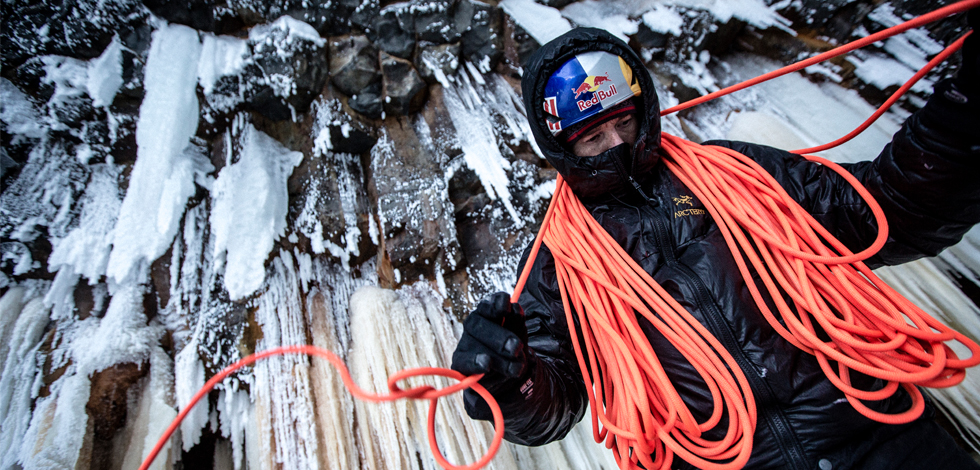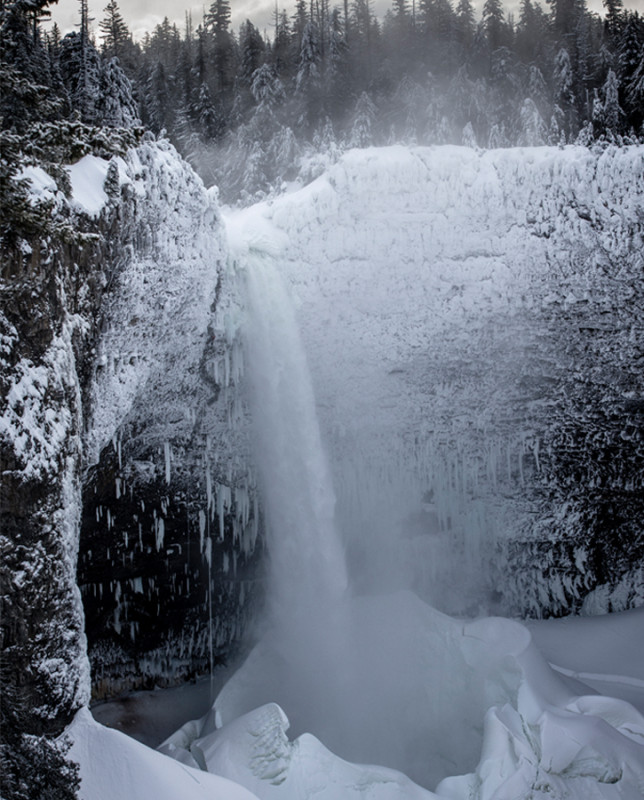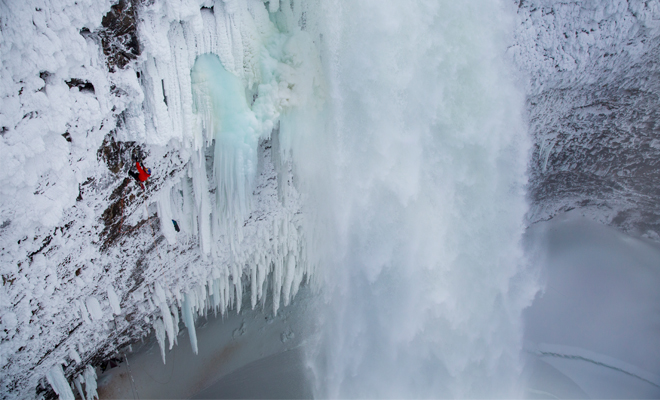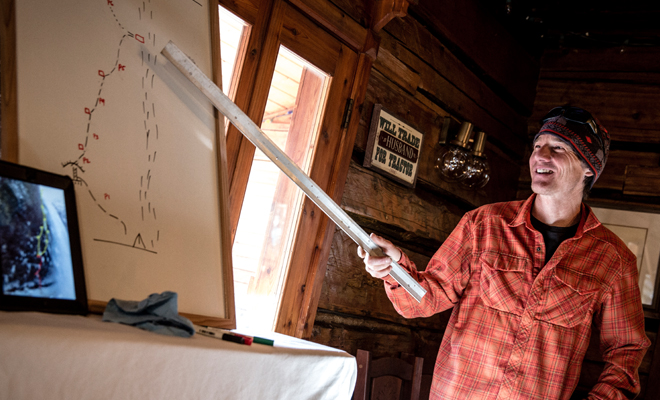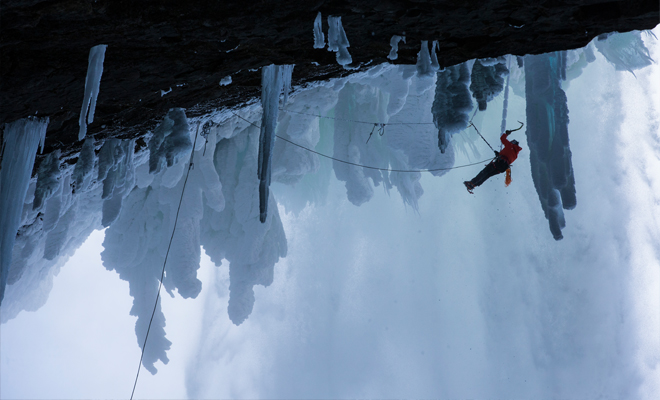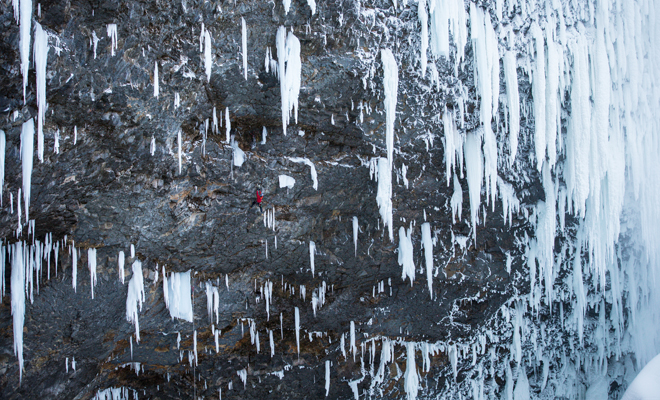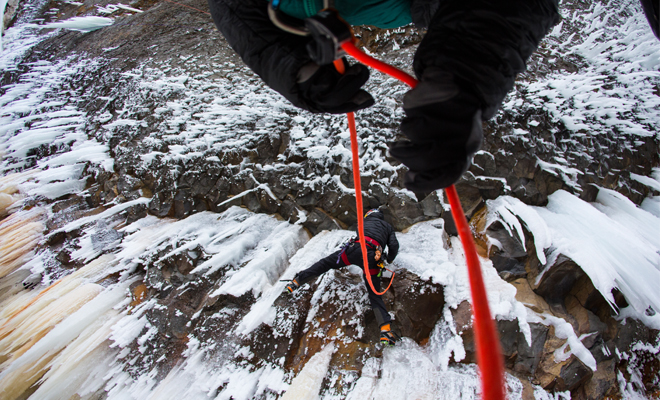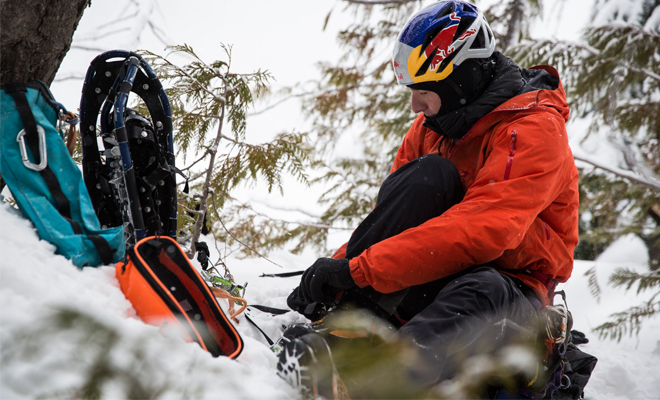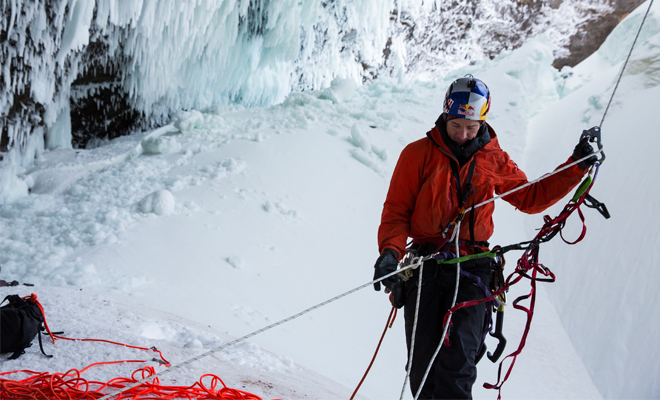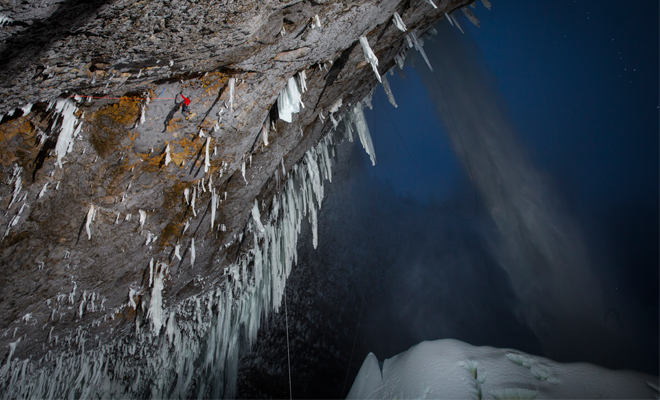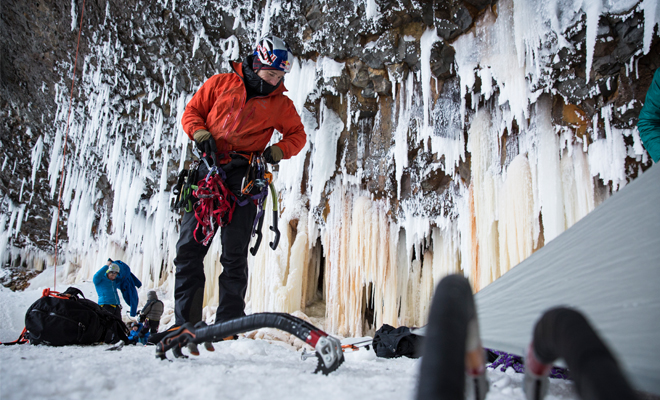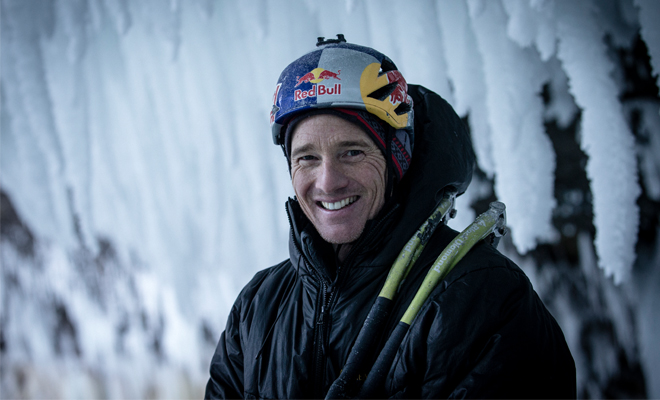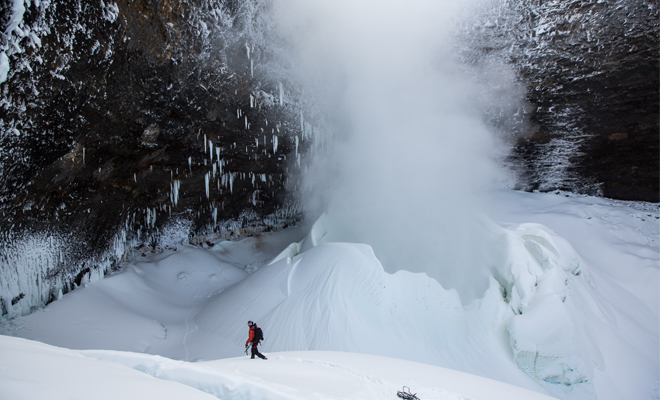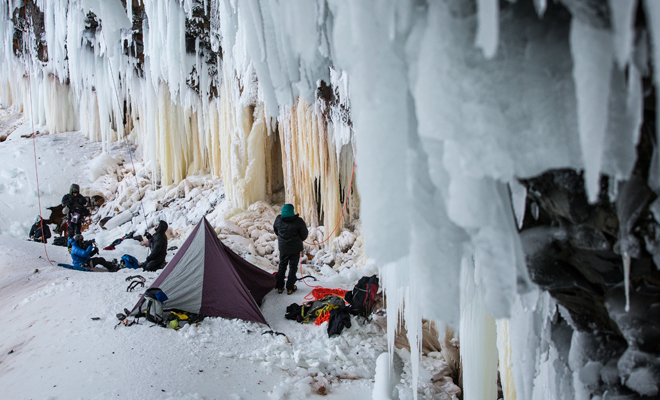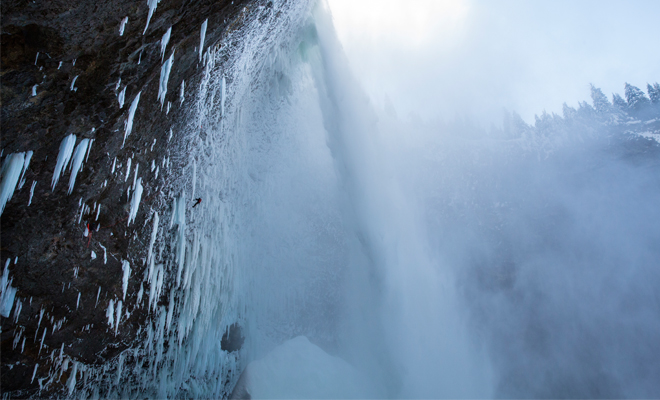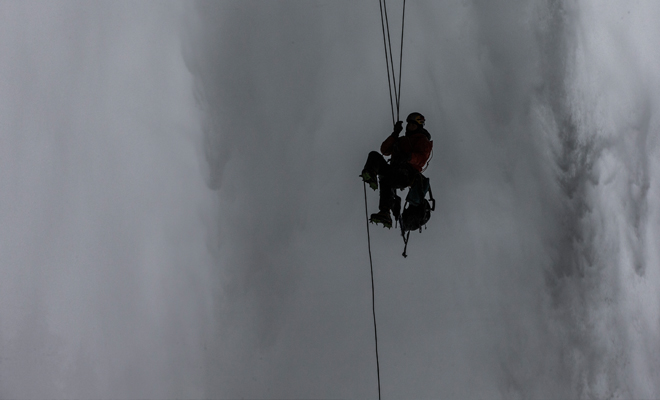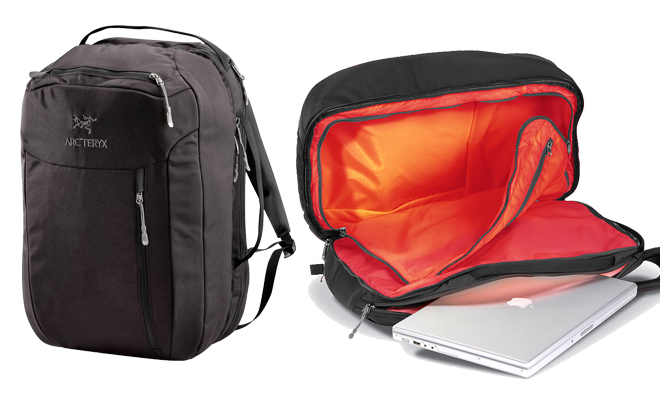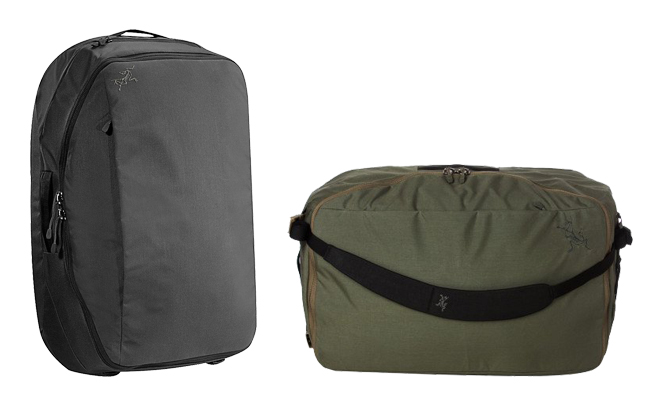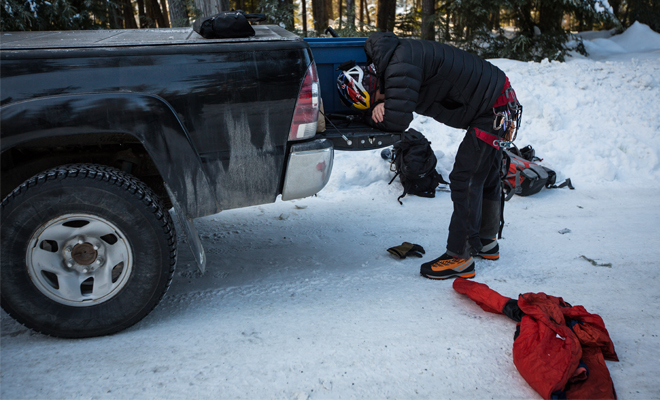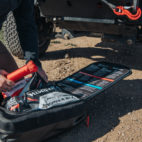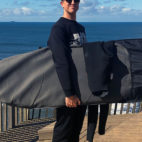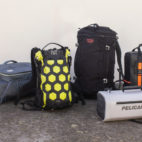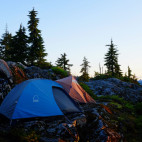Specialist Carry: Ice Climber
On an grey morning in early February, Will Gadd and his team trudged through the strenuous trails of Wells Gray Provincial Park to conquer British Columbia’s formidable Helmcken Falls. A soaring 450-foot waterfall that spews forth and cascades, crashing into the snow below to carve out the mouth of a colossal ice cone. Massive icicles, some weighing as much as a car, hang perilously from its underbelly like frozen spears, ready, at any moment, to rupture and plummet to its base with deadly force. It’s considered one of the world’s gnarliest climbs and the hardest mixed route in the world. And thanks to Arc’teryx, we caught up with Will, only a month after his great feat, to learn more about the brave man, his carry and the sport which he loves so much…
Only a month ago you climbed British Columbia’s Helmcken Falls, one of the world’s toughest and most epic mixed climbs. Can you tell us about why you challenged yourself with such a feat?
Helmcken Falls is simply the wildest looking, steepest, most difficult thing I could imagine climbing. It was a huge dream that took years to understand. Success is good!
How did you prepare?
Endless training, endless climbing at a very high level. The route is so sustained that I needed to be able to put out huge amounts of energy between each belay, and then do it seven more times. Most hard routes are really only hard for a short section, but the route at Helmcken stays hard all the way to the top! So lots of climbing hard pitches over and over, doing circuits in a special climbing gym where we can use our ice tools, and putting up really hard but relatively short routes. I got into the best shape of my life for sure, even better than when I won the Ice Climbing World Cup in 2000. I’m not that young anymore, so I was pleased that I could reach deeper into my body even at 46.
Hit me with the highlights?
Getting everybody into the climb and out safely. We had a four-person film crew, four other climbers, and a lot of very hazardous conditions to deal with. To manage that scene safely in one of the most hazardous places on earth is something I and the team can really be proud of.
And of course climbing the route. To have the fitness when I needed it, and to be able to dig deep and still climb at a high level. When months and years of hard preparation come together it’s a great feeling!
What kinds of obstacles did you have to endure and watch out for?
There are thousands of hanging icicles on the walls behind the falls, and they break off regularly. We had to navigate in and out of the climb without getting killed by a falling icicle. Then there was the spray from the falls itself, which coated our ropes – and us – in ice. And it was -30 or colder at times, which made it all much harder…
Ice climbing is brutal on gear. You want everything to weigh zero, but you’re playing with sharp toys like axes and crampons. Can you talk about that challenge?
Rather than making everything bomber enough to handle the sharp bits, just bring small bits to cover the sharp spikes. On my Nozone 55 the picks are stored outside the bag on the back, and I carry my crampons internally with my ice screws in a heavy-duty sort of stuff sack.
What things suck to carry?
Film gear. Tripods, awkward cameras, lenses, weird rigging bits. And kayaks, kayaks definitely suck to carry!
Any insights to share on packing for a climb or a trip?
I approach both business and outdoor trips as packing challenges… Go as light as you can, which is usually a lot lighter than you think. Look at what others have used on the same trip, then decide if your skills and attitude will allow you to do the same or go with less. I often bring a lot less hardware than other people on climbs as I need less. But I always bring more food as I run better on real food. In general most people bring too many “spares” on trips. You don’t need spares of everything, and your repair kit should be just solid enough to fix anything reasonably forseeable. For me that’s some duct tape, thread, done. You can always tie things together with climbing rope etc.
Tips for getting your climbing pack dialled?
Start with one that weighs three pounds or less empty. That gets rid of a lot of non-specific packs pretty quickly. Then make sure it does have the features you need – some people like to carry their crampons on the outside for example. Zips on climbing packs aren’t generally a good idea, a simple top-loader with a snow skirt/extender tube and floating lid is the best solution I’ve found. I do keep trying other systems, but simple just works. For cragging you can bring an Ikea bag and it’ll work out okay for a short walk in the woods, but a climbing pack is a piece of gear every bit as essential as your boots, and the same care should go into fitting it to your body and making sure it’s well designed.
Is it hard getting gear that works together really well? Like pack straps that don’t interfere with your jacket, or jackets that don’t mess with your harness?
It’s hard to get gear that’s actually been designed by real users. A lot of the packs I see on the market do all sorts of things that are completely irrelevant to winter sports. For example, exterior water bottle holders are pointless as water just freezes. Hydration hoses aren’t used in winter for the same reason, so having a hydration pocket in a winter pack is silly. I helped design the Arc’teryx system for holding jackets down inside a harness belt, that works great for me – nothing is more annoying than having a bit of skin exposed to the elements on your waist at -20 in a snowstorm.
Ice climbing is renowned for being an incredibly dangerous sport with a real risk of finally meeting your maker. Why do you keep going back time and time again? What do you love so much about it?
I love ice climbing because it’s so unlikely. Every time I climb ice I think, “This really shouldn’t work!” But it does, and with good training, gear and a proper mindset I feel it can be done with reasonable safety. Very rewarding moments in life are worth real risks; having kids is statistically far riskier than any extreme sport, yet people do it because kids are deeply rewarding and meaningful.
You mentioned a ‘proper mindset’, but what else makes a great ice climber?
One who keeps at it a long time with a good safety record.
Any guiding philosophies you live by?
“Today is a good day to do this right. One day I will die, but I’ll do what I can to make today not be that day.”
Do you have a favorite saying that you draw on for inspiration?
Naw, lots of good quotes out there. A lot of music goes through my head when I’m climbing well, from Henry Rollins to Kasabian to old Fugazi, just words and ideas about shutting the fuck up and doing the best you can.
How do you train for such a gruelling sport?
Endless doing of the sport. If you look at any top athlete 90 percent of his or her training will be doing the sport, or a close proximity to it. So I climb a lot, with a focus on my weaknesses and a plan shaped by my future goals. Baseline strengths for hard mixed climbing are the ability to do a one-arm pullup, a front lever, bench your own body weight for reps and hang onto a pullup bar for a minute straight. You’re fit enough to climb M13 if you can do that. “Normal” ice climbing can be done by anyone who can climb a flight of stairs or a ladder propped up against a house.
Who’s really doing rad things in the world of ice climbing and why?
Hmmm, I think pure ice climbing is stagnating a bit right now. It needs some reinvention, which will happen. Mixed climbing, meaning climbing ice and rock with the ice tools, is definitely going off.
What’s the biggest misunderstanding when it comes to the public and ice climbing?
That it has to be miserable. When I guide people ice climbing they stay warm, have a lot of fun and get to experience a unique world in a reasonably safe and comfortable environment.
When you’re trekking up the mountains in search of perfect ice what gear do you lug and why?
The list always depends on the climb and conditions. Just like travelling there is no one perfect list, but a collection of ideas and skills you can bring to bear on different situations. For ice climbing it’s likely you’ll need:
– Ice tools
– Crampons
– Harness
– Helmet
– Ice screws
– Rope
– A few pairs of thin gloves (thick gloves get sweaty inside and are then cold – better to bring multiple pairs of thin gloves and switch them out)
– Headlamp
– Very small first aid kit
– SPOT for emergency coms
– A warm Arc’teryx jacket and Gore Tex top
– Sugary food (eat a huge greasy breakfast, but run on carbs during the day, easier to digest and “normal” food just freezes anyhow)
– And then the list branches out to include things like sleeping bags, stoves (three lighters per stove!), etc. etc…
What carry challenges do you face when you’re trekking through the mountains?
I can have a lot of weight in my pack on the way in (climbing hardware is dense), and then not much on the climb itself. Finding one pack that’s light enough to climb with and also carries well is tricky.
What are your extravagances? What do you take with you climbing that you really shouldn’t?
Sometimes a small plastic bottle of scotch for trips where I know I’m going to have to bivy…
Being that you spend the majority of your time in sub-zero temps and ice-bound, what does that environment demand from your gear? What’s important design-wise?
Always depends on the day, but for sure high-end synthetic fabrics. Wool sucks, doesn’t dry well after even a few washes get rid of all the chemicals, synthetics rule for function. “Layers” are overrated; usually I move in a couple of very light base layers and thin shell even at very cold temps, and then put on a huge warm jacket and pants when not moving. That’s it. Layering was invented by someone who never spent any time actually MOVING in the mountains. Your body basically has two settings, “CRANK” and “SIT.” Even at -30 brisk walking will result in too much sweat unless you strip right down. Bring a dry skin layer to change into, makes a big difference and weighs nothing.
What do you look for when choosing what to climb? What makes for a perfect ice climb? What sends off warning bells and you try to avoid?
I like routes that no one has been up before, and that are obvious from a distance. A blue line ripping into the sky…
Once you kick off your ascent up the ice face, what gear do you use?
The rope and ice screws protect me in case of a fall, which I hopefully prevent with ice tools and crampons. A helmet isn’t just for show in ice climbing, you use it as a sort of shield to deflect pieces that break off when ice goes flying after hitting it with your ice tools.
Is there anything that present climbing gear doesn’t cater for?
Most hardware right now is too heavy and not use-specific enough. In 20 years it’s going to look radically different!
Have you ever had to modify any of your gear to suit you?
Pretty much all my hardware. My packs and softgoods generally not as much, but I know how to sew and often do cut and sew, especially when working on prototypes.
You’ve travelled the world climbing and I’m sure you’ve logged some serious travel time. So what have you learnt about the best ways to travel? Any favorite tips or habits for travelling better?
Avoid connecting flights through Heathrow at all costs. It’s an okay airport to fly directly into or out of, but a nightmare to connect through. Frankfurt has the best duty-free shopping, processes passengers well, and there is a ton of stuff to do in that airport. Show up early for flights, stress sucks.
Never get angry. Always look the counter person in the eye, ask for what you want, be pleasant. A lot of travellers are stressed out, unhappy, bitter people, unfortunately. If you walk up with a smile, say hello, listen to them and politely ask for what you want, well, I’ve been amazed over the years at the positive things that can happen. Modern travel is just not that great a lot of the time, but you can make it better.
Do you ever forget there’s sharp things in your pack and go to get on a plane?
Pre-9 11 I used to take my ice tools onto flights all the time, nobody seemed to mind. Not now. I use small knives to cut cord while climbing, and if I fly with my harness I sometimes forget to take that tiny knife off. I’ve lost a few of those.
How do you go on airplanes with all your climbing kit?
If I can get the crampons and ice tools from a contact where I’m going then I plan ahead and do that so I can fly with only carry-on luggage. If I have to I check the crampons and ice axes in a bag, which slows things down some.
Are there any features from other carry products (messengers, roller luggage, etc) that would be beneficial to you, that isn’t being utilized in what is currently out there for your specialized gear carry?
Hmmm, I travel a lot, and I think most travel baggage could benefit from going on a diet and studying good alpine pack and hardware design. Many travel bags weigh more than five pounds, which with modern weight restrictions is a crime. I’m a high status flyer with Star Alliance, so I can basically bring as much gear as I want, but I hate it when my rolling duffels weigh ten pounds and still break regularly under the loads I put them under.
I don’t like messenger bags much, they aren’t good to MOVE with in general, always having to flip them around to the back and flapping about when busting a move to the gate with ten minutes to spare. A good solid maximum legal carry-on backpack kicks butt on roller bags for moving fast. If you need a rolling carry-on bag then either it’s full of papers, fair enough, or you need to get your ass to the gym and shape up.
I wish all mountain and street bags had bright liners in them, it makes it way easier to find stuff.
Any nightmare travel stories? Had any run-ins with hostile customs officers?
The trick for customs around the world is to have your papers well in order and complete, respect the situation (stay behind the yellow/red/whatever line until called but then be prompt, take your hat/sunglasses off, say good afternoon/whatever), and look the customs person in the eye in a friendly but “We’re both doing our jobs here, thanks,” way. I very seldom get searched or hassled. The exception was in South America years ago, I screwed up in my bad Spanish and had to spend most of an afternoon explaining my way out of that one…
Always keep your gear in hand while travelling – a few years back I flew back into my home airport, Calgary, after a month in Brazil. I’d been hyper-vigilant in Brazil as I was in many poor and supposedly dangerous areas, but let my guard down in Calgary. As I was loading my gear into my girlfriend’s car someone stole my computer bag in the literally five seconds I turned away at curb side. Amazing. Only time I’ve been badly ripped off while travelling.
What’s your go-to travel bag?
Computer bag: Blade 30. I can bring my running shoes, rock climbing shoes, chalkbag, harness, spare shirt and pants in this bag, along with my computer. I love travelling with just one light bag when I go to speak at events around the world.
If I’m going for longer than a weekend I bring one of the Arc’teryx Covert ICO legal carry-on bags in addition to the Blade. The Covert carry-ons are great – super simple, clean, light (it’s just ridiculous what many carry-on bags weigh!).
Then duffels, endless duffels, and stuff sacks and other “blocks” that keep all my gear organized. And I’m an environmental criminal for how many ziplocks I go through. 🙂
What do you personally look for in good carry?
I have a huge selection of bags, it really depends on the situation. But I like high-quality gear that is the best at what it does. Sometimes I’ll sacrifice comfort for weight, or I’ll want more comfort so I can carry heavy weight for longer. There is no one perfect bag for even a small sample of situations unfortunately. But I like minimalistic, clean gear that’s honest. If a pack looks like a bondage experiment gone wrong then that’s what it will be when I’m carrying it. Zippers that are proportional to the loads they’ll have to resist; a main zipper on a duffel should be huge. The zipper on the inside of the top lid of a pack should be light and elegant in use and function.
I hate bags that don’t open fast too. And side zippers are worthless, any pack with a side zipper is made for people who clearly do not understand that you don’t just take things out of the middle/bottom of a pack with a side zipper, doing so screws the whole carry of the pack up. To make a bag carry well the user has to understand that the gear in the bag is part of the suspension system, and pack accordingly. When I see someone with a bunchy, lumpy, listing bag on their back I know that he or she is likely a relative novice in the outdoor sports world without any other signs. Look at guides and other people who carry stuff day in and day out – their bags always look well organized and clean, as well as being smaller than most of their clients despite having a radio, first aid kit and other stuff.
That said, one of my favorite packs ever does have a side zipper. I have never used it, and tolerate the design flaw because the rest of the pack is so good.
What single climbing moment has given you the biggest smile?
Hmmm…I think completing a 24-hour fundraising climb. I climbed for 24 hours straight, and it totally destroyed me, but I did it. The psyche from my team, the crowd, and just overcoming a huge goal left me smiling in a tired way for days.
And the diciest moment you’ve ever endured?
Almost dying when my knot came undone. Error.
What’s next for Will Gadd?
Africa. Two trips scheduled, I’m going ice climbing (for real!), and then flying my paraglider a long ways.
If you weren’t an ice climber, and all-round rad dude, what profession would you be doing now?
Probably some form of marketing/product research. In my late twenties I had a company that did work for Nike and other major companies, I loved figuring out how and why people made decisions. I also worked in publishing and as a writer, so lots of options. I still use all those skills today; without them I couldn’t present what I do to the public in the same way…
Anything you’d like to mention that I’ve missed?
Just that carrying stuff is a human necessity, from children to rocks, and it’s cool to see your focus on it!
For kid carriers external frame packs rock for kids over six months old. 🙂
Wheels are the ticket in urban environments and function trumps bullshit every single time it matters.
*Big thanks to the Red Bull team for all of the awesome images 🙂





 Carry Awards
Carry Awards Insights
Insights Liking
Liking Projects
Projects Interviews
Interviews
